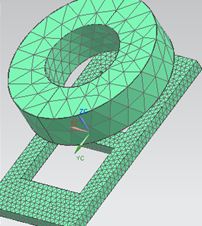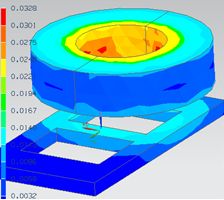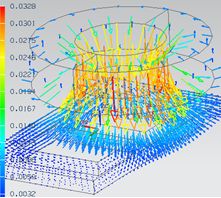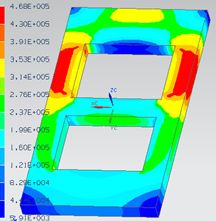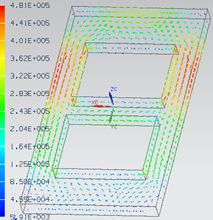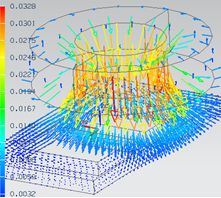 Die magneto-dynamische Lösung im Frequenzbereich beschreibt die Verteilung von Magnetfeldern und Wirbelströmen aufgrund von zeitharmonischen Erregungslasten.
Die magneto-dynamische Lösung im Frequenzbereich beschreibt die Verteilung von Magnetfeldern und Wirbelströmen aufgrund von zeitharmonischen Erregungslasten.
Wir verwenden eine quasi stationäre Näherung. Die Annahmen gelten in Fällen mit Abmessungen << Wellenlänge. Beispiele sind Motoren, Transformatoren und Frequenzen von 0 Hz bis zu einigen 100 kHz.
Features
- 2D, 3D or axisymmetric Solution
- coupled with Thermal solution possible
- Outputs Plot:
- Magnetic Fluxdensity, Magnetic Fieldstrength, Current Density, Eddy Current Losses Density, Hysteresis-, Eddy-, Excess Loss Density - steinmetz, Magnetic Potential (a-Pot).
- Outputs Table:
- RotorBand Torque - stresstensor, Magnetic Potential on Conductors - Fluxlinkage, Voltage on Coils, Voltage on Circuits, Electrode Voltage, Electrode Current, Current on Circuits, Power on Circuits, Eddy Current Losses, Hysteresis-, Eddy-, Excess Losses, Ohm Resistance, Coil Inductivity, Phase Shift.
Examples
| Transformer Analysis | Circuit Breaker | Lamination Losses | AC Cable |
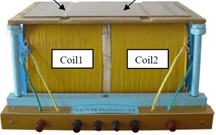 |
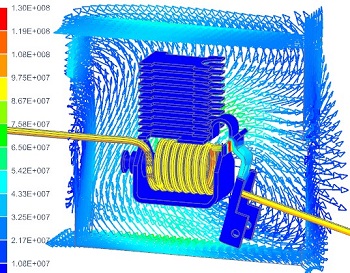 |
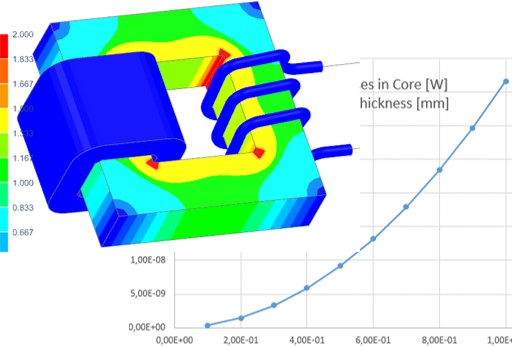 |
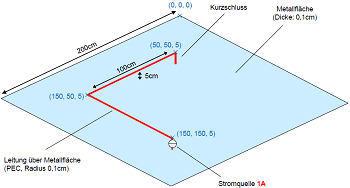 |
Theory and Basics
Formulations
The basis equations:
(1) rot h = j
(2) rot e = -δt b
(3) div b = 0
Constitutive relations:
(4) b = µ h
(5) j = σ e
a-Formulation
The following a-formulation is used for 2D-Magnetodynamics.
Magnetic vectorpotential a:
(6) b = rot a
(7) e = -δt a
Magnetodynamic weak a-formulation:
(8) ( µ-1 rot a, rot a’ )Ω
+ (-µ-1 bs, rot a’ ) Ω
+ (- j, a’ ) ΩC
+ (σ δt a, a’ ) Ωc
= 0, for all a’ element of Ω
a-v-Formulation
The following a-v-formulation is used for 3D-Magnetodynamics.
Magnetic vectorpotential a, electric scalar potential v:
(9) b = rot a
(10) e = -δt a – grad v
Magnetodynamic weak a-v-formulation:
(11) (µ-1 rot a, rot a’ )Ω
+ (σ δt a, a’ ) Ωc
+ (σ grad v, a’ ) Ωc
+ (σ δt a, grad v’ ) Ωc
+ (σ grad v, v’ ) Ωc
= 0
Basic Example: Team Problem 3: The Bath Plate
The problem 3 of the TEAM (Testing Electromagnetic Analysis Methods) is one of the examples for testing eddy current codes. A conductive plate with two holes is placed under a coil. The coil is driven by alternating current of 50 Hz and 1260 ampere turns. The goal is to analyze for the magnetic fluxdensity along a line that goes slightly over the plate.
The Mesh is shown in the following picture.
Results: Fluxdensity and Induced Current
The magnetic fluxdensity as contourplot
The magnetics fluxdensity as vectorplot
The induced current density as contourpolot
The induced current density as vectorplot


